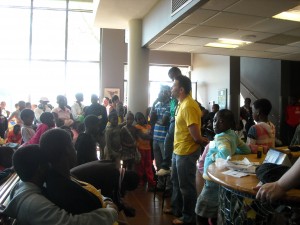Efficiency to Inefficiency, back to Efficiency!
The latter half of this week largely focused on getting a translator for the dosing clip study. After getting a protocol finalized, we took it to Macmillian Publishing Company in Masapha for translation by an official translator. I had never been to a publishing company, so getting to see the warehouse a pretty fun experience. As for the translator himself, he were very efficient in his translations- he called the next morning and said that it was ready!
I also shadowed Dr. Kelly, who is a visiting scholar here, for a while. Apart from seeing patients, she showed me how the labs were read. One interesting point that came up was how there was some inefficiency getting the lab results interpreted and into the patients charts. Since the COE has computerized patient information and paper data, the lab reports (which are computerized initially) are printed, given to the doctors who interprets them and enters the abnormal lab reports in the computer system, and then the normal lab reports are given to someone else to enter in the computer. It would be much more efficient if the lab reports could be directly filed electronically for the patient, rather than having the middle paper step.
Following the TB nurse, we were able to observe one really interesting fact regarding the health care system here: because there are so few doctors, nurses many times take the role of the doctor for the simple patient cases. They are able to prescribe antibiotics for any of the patients complaints and are able to give refills of ARTs. This is a huge difference from health care in the US!
As the first full week draws to a close, we began thinking about possible projects to improve some aspects of the health care here. One of the most apparent concerns which significantly effects health in Swaziland is that HIV is killing the middle-aged people, leaving many HIV+ children in the care of the older, grandparent generation. These problems are all worsened by the fact that mothers normally have many children- sometimes up to 10- who are HIV+. Of course, family planning can help alleviate the problem, and the COE offers multiple family planning options. Thus, one project idea that we had was to educate the patients in the waiting room of their options for family planning by having readily available one-page brochures in Siswati on the topic. We talked to the family planning nurse, Ann, and she showed us the various contraception methods that the clinic has to offer. We think that if the patients are informed of the methods while waiting in the waiting room, they can think about it and ask their doctor when they see them. Quite an efficient use of time for them, indeed!




